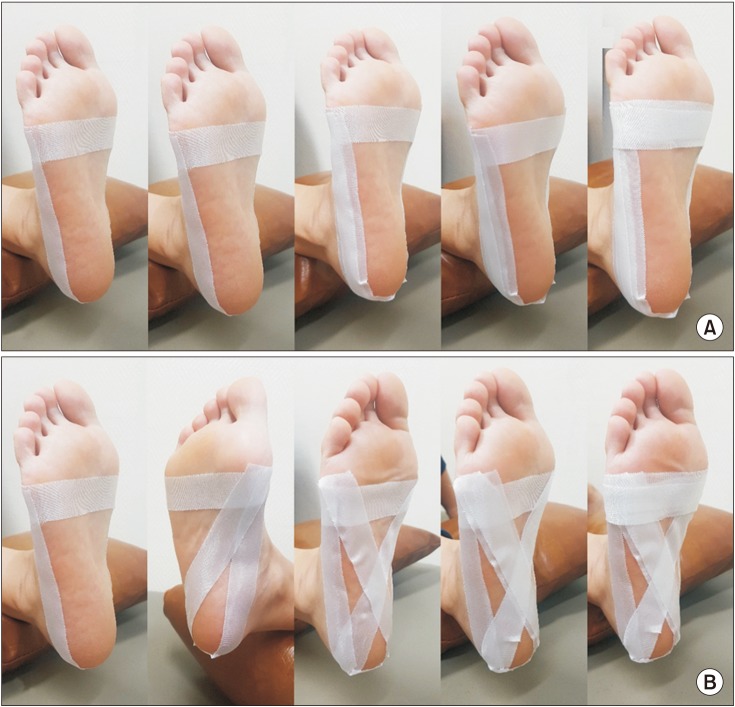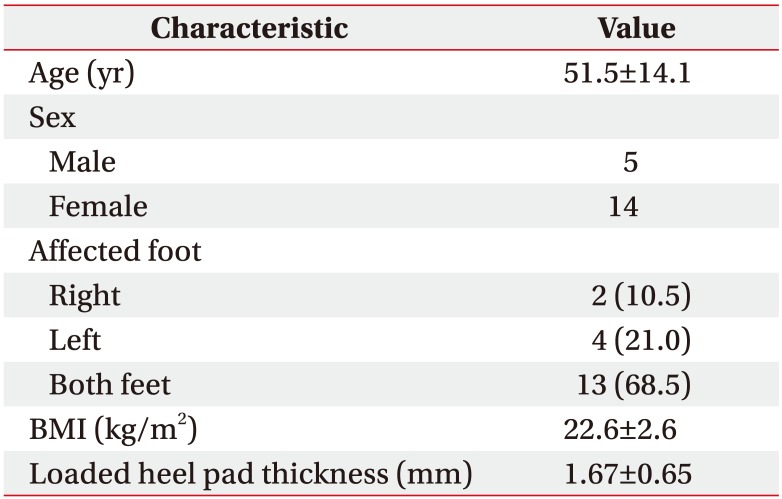1. Saxelby J, Betts RP, Bygrave CJ. ‘Low-dye’ taping on the foot in the management of plantar fasciitis. Foot (Edinb). 1997; 7:205–209.
2. Radford JA, Landorf KB, Buchbinder R, Cook C. Effectiveness of low-dye taping for the short-term treatment of plantar heel pain: a randomised trial. BMC Musculoskelet Disord. 2006; 7:64. PMID:
16895612.

3. Park C, Lee S, Lim DY, Yi CW, Kim JH, Jeon C. Effects of the application of Low-Dye taping on the pain and stability of patients with plantar fasciitis. J Phys Ther Sci. 2015; 27:2491–2493. PMID:
26355306.

4. Van Lunen B, Cortes N, Andrus T, Walker M, Pasquale M, Onate J. Immediate effects of a heel-pain orthosis and an augmented low-dye taping on plantar pressures and pain in subjects with plantar fasciitis. Clin J Sport Med. 2011; 21:474–479. PMID:
22011796.

5. Landorf KB, Keenan AM, Herbert RD. Effectiveness of foot orthoses to treat plantar fasciitis: a randomized trial. Arch Intern Med. 2006; 166:1305–1310. PMID:
16801514.
6. Ha HS, Hwang JH, Kim YB, Ha YM, Hwang JM. Immediate clinical and biomechanical effects of lowdye taping in patients with plantar heel pain. Korean J Sports Med. 2012; 30:9–15.

7. Lange B, Chipchase L, Evans A. The effect of low-dye taping on plantar pressures, during gait, in subjects with navicular drop exceeding 10 mm. J Orthop Sports Phys Ther. 2004; 34:201–209. PMID:
15128190.

8. Vicenzino B, McPoil T, Buckland S. Plantar foot pressures after the augmented low dye taping technique. J Athl Train. 2007; 42:374–380. PMID:
18059993.
9. O'Sullivan K, Kennedy N, O'Neill E, Ni Mhainin U. The effect of low-dye taping on rearfoot motion and plantar pressure during the stance phase of gait. BMC Musculoskelet Disord. 2008; 9:111. PMID:
18710520.
10. Yi TI, Shim JW, Ku HK, Seo IS, Huh WS, Kim JS, et al. The effects of modified low-dye taping in the patient with heel pad atrophy. J Korean Acad Rehabil Med. 2011; 35:96–100.
11. Yi TI, Lee GE, Seo IS, Huh WS, Yoon TH, Kim BR. Clinical characteristics of the causes of plantar heel pain. Ann Rehabil Med. 2011; 35:507–513. PMID:
22506166.

12. Turgut A, Gokturk E, Kose N, Seber S, Hazer B, Gunal I. The relationship of heel pad elasticity and plantar heel pain. Clin Orthop Relat Res. 1999; (360):191–196.

13. Pfeffer G, Bacchetti P, Deland J, Lewis A, Anderson R, Davis W, et al. Comparison of custom and prefabricated orthoses in the initial treatment of proximal plantar fasciitis. Foot Ankle Int. 1999; 20:214–221. PMID:
10229276.

14. Russo SJ, Chipchase LS. The effect of low-dye taping on peak plantar pressures of normal feet during gait. Aust J Physiother. 2001; 47:239–244. PMID:
11722292.

15. Nolan D, Kennedy N. Effects of low-dye taping on plantar pressure pre and post exercise: an exploratory study. BMC Musculoskelet Disord. 2009; 10:40. PMID:
19383160.

16. Newell T, Simon J, Docherty CL. Arch-taping techniques for altering navicular height and plantar pressures during activity. J Athl Train. 2015; 50:825–832. PMID:
26098272.

17. Radford JA, Burns J, Buchbinder R, Landorf KB, Cook C. The effect of low-dye taping on kinematic, kinetic, and electromyographic variables: a systematic review. J Orthop Sports Phys Ther. 2006; 36:232–241. PMID:
16676873.

18. SMCBC Curriculum Committee. Manual of athletic taping. Philadelphia: F. A. Davis;1995. p. 26–30.
19. Rhee WI, Kim JM. Ultrasonographic findings of thickness and compressibility of heel pads in outpatient. J Korean Soc Med Ultrasound. 2004; 23:213–218.
20. Del Rossi G, Fiolkowski P, Morodyski MB, Bishop M, Trimble M. For how long do temporary techniques maintain the height of the longitudinal arch? Phys Ther Sport. 2004; 5:84–89.
21. Ator R, Gunn K, McPoil TG, Knecht HG. The effect of adhesive strapping on medial longitudinal arch support before and after exercise. J Orthop Sports Phys Ther. 1991; 14:18–23. PMID:
18796830.






 PDF
PDF ePub
ePub Citation
Citation Print
Print






 XML Download
XML Download